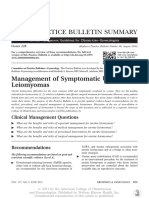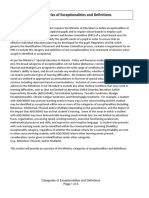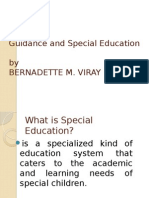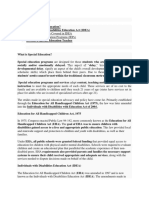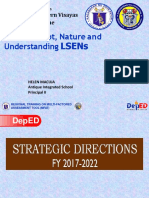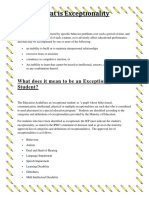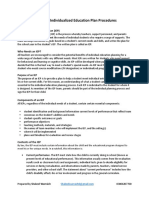Chapter 5: Low Incidence Disabilities
Chapter 5: Low Incidence Disabilities
Uploaded by
Iqra MunirCopyright:
Available Formats
Chapter 5: Low Incidence Disabilities
Chapter 5: Low Incidence Disabilities
Uploaded by
Iqra MunirOriginal Title
Copyright
Available Formats
Share this document
Did you find this document useful?
Is this content inappropriate?
Copyright:
Available Formats
Chapter 5: Low Incidence Disabilities
Chapter 5: Low Incidence Disabilities
Uploaded by
Iqra MunirCopyright:
Available Formats
Chapter 5: Low Incidence Disabilities
Definition
Low Incidence Disability Defined Low incidence disability is defined as a severe disabling condition with
an expected incidence rate of less than one percent of total statewide enrollment in special education.
Definitions of disabilities categorized as low-incidence vary in scope. Broadly defined, low-incidence
disabilities refer to a visual impairment or hearing loss, deaf-blindness, and significant cognitive
impairment. For children, the definition extends to any impairment that requires individualized
intervention services provided by professionals with highly specialized skills and knowledge in order for
the child to benefit from his or her education.
Low Incidence Disabilities are:
1. Autism Spectrum Disorders (ASD) is defined as a range of pervasive developmental disorders,
with onset in childhood, that adversely affect a pupil's functioning and result in the need for
special education instruction and related services. ASD is a disability category characterized by
an uneven developmental profile and a pattern of qualitative impairments in several areas of
development, including social interaction, communication, or the presence of restricted,
repetitive, and stereotyped patterns of behavior, interests, and activities.
2. Deaf and Hard of Hearing (DHH) means a diminished sensitivity to sound, or hearing loss, that is
expressed in terms of standard audio logical measures. Hearing loss has the potential to affect
educational, communicative, or social functioning that may result in the need for special
education instruction and related services.
3. DeafBlind (DB) means concomitant hearing and vision impairments, the combination of which
causes such severe communication and other developmental and educational needs that they
cannot be accommodated in special education programs solely for children with deafness or
children with blindness.
4. Other Health Disabilities (OHD) is defined as a wide range of chronic or acute health conditions
that may be either congenital or acquired. Health disabilities may be mild or severe, progressive,
and/or have symptoms that vary in intensity from day to day. Medications, treatments,
therapies, and repeated hospitalizations for a range of chronic or acute health conditions can
affect a student’s ability to learn and function at school.
5. Physically Impaired (PI) is a low incidence disability area that is represented by approximately
1% of all students in Minnesota receiving special education services. PI is defined as a medically
diagnosed, chronic physical impairment - either congenital or acquired - that may adversely
affect physical or academic functioning and result in the need for special education and related
services.
6. Traumatic Brain Injury (TBI) is a low incidence special education category that is defined as an
injury to the brain caused by an external physical force, resulting in total or partial functional
disability and/or psycho-social impairment that may adversely affect a student's performance
and result in the need for special education and related services. The term does not apply to
brain injuries that are congenital or degenerative, or brain injuries induced by birth trauma.
7. Visually Impaired (BVI) means a medically verified visual impairment accompanied by
limitations in sight that interfere with acquiring information or interaction with the environment
to the extent that special education instruction and related services may be needed
8. Developmental Cognitive Disabilities (DCD), which includes students labeled DCD Mild-
Moderate and DCD Severe-Profound, is defined as a condition that results in intellectual
functioning significantly below average and that is associated with concurrent deficits in
adaptive behavior that require special education and related services.
9. Severely Multiply Impaired (SMI) means a student who has severe learning and developmental
problems resulting from two or more disability conditions, including deaf/hard of hearing,
physically impaired, developmental cognitive disability: severe-profound range, visually
impaired, emotional or behavioral disorders, or autism spectrum disorders.
More details are on the below link.
https://www.slideshare.net/sander60tx/low-incidence-disabilities
Services to Low Incidence Disabilities
The IEP team determines the Services for the student. A student must have a service code identified in
their IEP that is appropriate to the service that is being provided.
• Specialized Services for Low Incidence Disabilities: Low incidence services are defined as those
provided to the student population of orthopedically impaired (OI), visually impaired (VI), deaf,
hard of hearing (HH), or deaf-blind (DB). Typically, services are provided in education settings by
an itinerant teacher or an itinerant teacher/specialist. Consultation is provided to the teacher,
staff and parents as needed. These services must be clearly written in the student's IEP,
including frequency and duration of the services to the student.
• Specialized Deaf and Hard of Hearing Services: These services include speech therapy, speech
reading, auditory training and/or instruction in the student's mode of communication.
Rehabilitative and educational services; adapting curricula, methods, and the learning
environment; and special consultation to students, parents, teachers, and other school
personnel may also be included.
• Specialized Vision Services: This is a broad category of services provided to students with visual
impairments. It includes assessment of functional vision; curriculum modifications necessary to
meet the student's educational needs, including Braille, large type, and aural media; instruction
in areas of need; concept development and academic skills; communication skills (including
alternative modes of reading and writing); social, emotional, career, vocational, and
independent living skills. It may include coordination of other personnel providing services to
the students (such as transcribers, readers, counselors, orientation and mobility specialists,
career/vocational staff, and others) and collaboration with the student's classroom teacher.
• Audiological Services: These services include measurements of acuity, monitoring amplification,
and frequency modulation system use. Consultation services with teachers, parents or speech
pathologists must be identified in the IEP as to reason, frequency and duration of contact;
infrequent contact is considered assistance and would not be included.
You might also like
- Acog Practice Bulletin Summary: Management of Symptomatic Uterine LeiomyomasDocument3 pagesAcog Practice Bulletin Summary: Management of Symptomatic Uterine LeiomyomasMariana Hernandez100% (6)
- Special Education Chapter 3Document31 pagesSpecial Education Chapter 3faulo franciscoNo ratings yet
- Respiratory SystemDocument32 pagesRespiratory Systemapi-202513022No ratings yet
- Exercises in Oral Radiographic InterpretationsDocument239 pagesExercises in Oral Radiographic InterpretationsSufaru Ciprian75% (4)
- Types of Classrooms in Special EducationDocument3 pagesTypes of Classrooms in Special EducationMaaz KhanNo ratings yet
- What Is Special EducationDocument11 pagesWhat Is Special EducationRose Marie BalmoresNo ratings yet
- What Is Special EducationDocument24 pagesWhat Is Special EducationCandace Durano EspejonNo ratings yet
- Special EducationDocument4 pagesSpecial EducationArgie Cayabyab CagunotNo ratings yet
- Special Education Plan Categories and Definitions of ExceptionalitiesDocument6 pagesSpecial Education Plan Categories and Definitions of ExceptionalitiesGerald TamondongNo ratings yet
- University of Cebu Lapu-Lapu and Mandaue: A.C. Cortes Ave., Looc, Mandaue, PhilippinesDocument12 pagesUniversity of Cebu Lapu-Lapu and Mandaue: A.C. Cortes Ave., Looc, Mandaue, PhilippinesZel ZozobradoNo ratings yet
- Unit 3 Foundations of Special and Inclusive EducationDocument6 pagesUnit 3 Foundations of Special and Inclusive Educationjohnkennethdelacruz003No ratings yet
- Glossaryofterms03 12Document8 pagesGlossaryofterms03 12Anonymous fCdhLmyq3aNo ratings yet
- 13 Categories Under IDEA PDFDocument48 pages13 Categories Under IDEA PDFAlina NoreenNo ratings yet
- Final ExamDocument5 pagesFinal Examkristenereeves100% (12)
- Introduction To Inclusive EducationDocument137 pagesIntroduction To Inclusive EducationFeven SolomonNo ratings yet
- PS4.docx REVIEWERDocument6 pagesPS4.docx REVIEWERCarmela IsabellaNo ratings yet
- Section 2.7 - Categories of Exceptionalities and Definitions PDFDocument5 pagesSection 2.7 - Categories of Exceptionalities and Definitions PDFAlona Manabat SerratoNo ratings yet
- Maricris L. Llano: SPED 608Document4 pagesMaricris L. Llano: SPED 608MARICRIS LLANONo ratings yet
- Guidance and Special Education 1Document53 pagesGuidance and Special Education 1kepvinNo ratings yet
- Terms in Special EducationDocument6 pagesTerms in Special Educationsimiyulevin6No ratings yet
- What Is Special EducationDocument10 pagesWhat Is Special EducationCaressie BiscoNo ratings yet
- PS4 Midterm LectureDocument37 pagesPS4 Midterm Lectureuntalansmeralda36No ratings yet
- Learners With Physical Disabilities- JessicaDocument5 pagesLearners With Physical Disabilities- JessicashenmeenieNo ratings yet
- Inclusiveness Chapter OneDocument155 pagesInclusiveness Chapter OneHlina0% (1)
- Maricris L. Llano: SPED 608Document4 pagesMaricris L. Llano: SPED 608MARICRIS LLANONo ratings yet
- ExplainDocument9 pagesExplainErlyn CuevasNo ratings yet
- Special Education Lesson 1Document9 pagesSpecial Education Lesson 1Juliet SoriaNo ratings yet
- Skip To Main ContentDocument33 pagesSkip To Main ContentCharmaine BeltranNo ratings yet
- Study Guide Module 1 Foundations of Special and Inclusive EducationDocument7 pagesStudy Guide Module 1 Foundations of Special and Inclusive Educationreyes alvarezNo ratings yet
- Profed Sir Patrick Inclusive 1-4Document26 pagesProfed Sir Patrick Inclusive 1-4smileydaintyNo ratings yet
- Definition, Goals, and Scope of Special and Inclusive EducationDocument7 pagesDefinition, Goals, and Scope of Special and Inclusive EducationMaia Gabriela100% (1)
- Study Guide Module 1 Prof ED 103Document7 pagesStudy Guide Module 1 Prof ED 103Darlene Dacanay DavidNo ratings yet
- AssignmentsDocument5 pagesAssignmentsEdmon AlturaNo ratings yet
- Chapter 2 Continuum of Need and Types of NeedDocument7 pagesChapter 2 Continuum of Need and Types of NeedTauqeer AhmedNo ratings yet
- P2 Edu 539 FSDocument72 pagesP2 Edu 539 FSamorflores112602No ratings yet
- FINAL TERM HANDOUT 1 Categories of ExceptionalitiesDocument6 pagesFINAL TERM HANDOUT 1 Categories of ExceptionalitiesKier MahusayNo ratings yet
- Access To The General Curriculum (AGC)Document10 pagesAccess To The General Curriculum (AGC)Asiah JohnsonNo ratings yet
- Educ 104 Reviewer 1Document32 pagesEduc 104 Reviewer 1Zerene Concepcion100% (2)
- Report MarjDocument3 pagesReport MarjNihar Maruhom GubarNo ratings yet
- Special Education Coding Criteria 2014Document4 pagesSpecial Education Coding Criteria 2014api-307218927No ratings yet
- Categories of Disability Under IDEAmasterDocument19 pagesCategories of Disability Under IDEAmasterqueengielinNo ratings yet
- Autism:: Autism Is A Lifelong, Non-Progressive Neurological Disorder Typically Appearing BeforeDocument3 pagesAutism:: Autism Is A Lifelong, Non-Progressive Neurological Disorder Typically Appearing Beforeadil khanNo ratings yet
- Sped and AlsDocument20 pagesSped and Alsrose dianne reyesNo ratings yet
- Lecturenote - 745911168introduction To Special Needs EducationDocument46 pagesLecturenote - 745911168introduction To Special Needs Educationas576542007No ratings yet
- Basic Concept, Nature & Understanding LSENs (Bam Imas) FinaleDocument49 pagesBasic Concept, Nature & Understanding LSENs (Bam Imas) Finalerhoda mae ypulongNo ratings yet
- Essential Concepts of Special Education: Combo, Celeste Esguerra, Mikaella Mae C. Ramirez, CatherineDocument21 pagesEssential Concepts of Special Education: Combo, Celeste Esguerra, Mikaella Mae C. Ramirez, CatherineCeleste NavalNo ratings yet
- Sped 601Document16 pagesSped 601Jesleigh PerezNo ratings yet
- Special EducationDocument38 pagesSpecial EducationJb FuertesNo ratings yet
- Special EducationDocument66 pagesSpecial EducationMaureen AstherelleNo ratings yet
- Embracing Special EducationDocument46 pagesEmbracing Special EducationNowmee DanlogNo ratings yet
- Psychology UNIT-4Document67 pagesPsychology UNIT-4krish.reddy506No ratings yet
- MODULE 3 SPED and Categories of Children With Special NeedsDocument5 pagesMODULE 3 SPED and Categories of Children With Special NeedsUkulele Princess100% (1)
- Components of Special Needs EducationDocument55 pagesComponents of Special Needs Educationjoyce serraNo ratings yet
- Study-Guide-Module-1-Foundations of Special and Inclusive EducationDocument8 pagesStudy-Guide-Module-1-Foundations of Special and Inclusive EducationHAZEL FERRERIA BASTONo ratings yet
- Sammy ExceptionalityDocument8 pagesSammy ExceptionalityShacara MillingtonNo ratings yet
- Inclusive EducationDocument118 pagesInclusive EducationBelay KassahunNo ratings yet
- 5 MultipleDocument7 pages5 Multipleapi-238075370No ratings yet
- ED 205 Module FinalDocument151 pagesED 205 Module FinalGene Bryan SupapoNo ratings yet
- Orthopedic ImpairmentDocument19 pagesOrthopedic Impairmentapi-238075370No ratings yet
- Classification of Exceptionalities: Welcome, Students!Document28 pagesClassification of Exceptionalities: Welcome, Students!alipao randyNo ratings yet
- Inclusive (PGDT) - 1Document106 pagesInclusive (PGDT) - 1tadessewale39No ratings yet
- Overcoming Learning Disabilities: Strategies for Parents and EducatorsFrom EverandOvercoming Learning Disabilities: Strategies for Parents and EducatorsNo ratings yet
- Therapeutic Education Direction & Intervention (TEDI): Volume 2: Activity Kits for Special Needs Children: Communication and Gross MotorFrom EverandTherapeutic Education Direction & Intervention (TEDI): Volume 2: Activity Kits for Special Needs Children: Communication and Gross MotorNo ratings yet
- Text Book Development 1Document24 pagesText Book Development 1Iqra MunirNo ratings yet
- Learning To Read and Write in A Multilingual ContextDocument5 pagesLearning To Read and Write in A Multilingual ContextIqra MunirNo ratings yet
- The 5 Subsystems of LanguageDocument2 pagesThe 5 Subsystems of LanguageIqra MunirNo ratings yet
- Chapter 4: Individualized Education Plan ProceduresDocument4 pagesChapter 4: Individualized Education Plan ProceduresIqra MunirNo ratings yet
- Introduction To Inclusive Education: 1. Definition and Concept of InclusionDocument5 pagesIntroduction To Inclusive Education: 1. Definition and Concept of InclusionIqra MunirNo ratings yet
- Assingment - Subject: Eduction For Sustainable Development. - Course Code: EDUC3146. - Topic: Challenges SD & Sustainable SolutionsDocument18 pagesAssingment - Subject: Eduction For Sustainable Development. - Course Code: EDUC3146. - Topic: Challenges SD & Sustainable SolutionsIqra MunirNo ratings yet
- 6522 PaperDocument5 pages6522 PaperIqra Munir0% (1)
- 6553 PaperDocument5 pages6553 PaperIqra MunirNo ratings yet
- Criticize The Role of GTZ Model For Designing Science Textbooks PakistanDocument1 pageCriticize The Role of GTZ Model For Designing Science Textbooks PakistanIqra Munir0% (1)
- Chapter 1 SDDocument9 pagesChapter 1 SDIqra MunirNo ratings yet
- Chapter 2: Methods of Educational ResearchDocument7 pagesChapter 2: Methods of Educational ResearchIqra MunirNo ratings yet
- SD MCQsDocument18 pagesSD MCQsIqra MunirNo ratings yet
- Worksheet - Life ProcessesDocument4 pagesWorksheet - Life ProcessesPadma pulivarthiNo ratings yet
- CD HandoutsDocument80 pagesCD HandoutsMayflor GuiyabNo ratings yet
- Femto-Lasik Laser Surgery: How Does It Work?Document4 pagesFemto-Lasik Laser Surgery: How Does It Work?vrlftrNo ratings yet
- How To Achieve SuperhealthDocument24 pagesHow To Achieve SuperhealthJulian Williams©™No ratings yet
- Arab-Board ExamDocument104 pagesArab-Board Examahmed.farag.ali2020No ratings yet
- ThermoregulationDocument52 pagesThermoregulationanon_12594291650% (2)
- Pediatric Emergencies 1Document101 pagesPediatric Emergencies 1VIPIN V NAIR100% (1)
- Lalap InsertDocument1 pageLalap InsertTabe RasoolNo ratings yet
- Practical 1 Lab Report BIO301 PDFDocument5 pagesPractical 1 Lab Report BIO301 PDFfar50% (2)
- Registered Dental Hygienist Law and Ethics Written ExaminationDocument12 pagesRegistered Dental Hygienist Law and Ethics Written ExaminationDaraí Bárbara Sánchez MonteroNo ratings yet
- Final Announcement ACIC ACEM SCU CME PDFDocument23 pagesFinal Announcement ACIC ACEM SCU CME PDFFredik JackyNo ratings yet
- Colonial Reports Annual N° 613 Gold Coast - Reports For 1908 - Rep RienDocument57 pagesColonial Reports Annual N° 613 Gold Coast - Reports For 1908 - Rep RienEmmanuelleLizéNo ratings yet
- Ahp BrazilDocument22 pagesAhp BrazilazhariNo ratings yet
- PosadaLaura 2024 IncriminatingLeishmaniasesVectorsDocument10 pagesPosadaLaura 2024 IncriminatingLeishmaniasesVectorsJulian CatañoNo ratings yet
- Icp Member Handbook Il PDFDocument36 pagesIcp Member Handbook Il PDFjohnNo ratings yet
- Abbreviation List For Medical Record Documentation V20Document11 pagesAbbreviation List For Medical Record Documentation V20Hyoyeon KimNo ratings yet
- Bacterial VaginosisDocument20 pagesBacterial VaginosisTum M. TansakulNo ratings yet
- Scara de Severitate MNIDocument4 pagesScara de Severitate MNIDM XyzNo ratings yet
- Principles of Tooth Preparation Punam BishnoiDocument125 pagesPrinciples of Tooth Preparation Punam BishnoiPunam Bishnoi75% (4)
- Solna TR K 11809-23 Aktbil 2, Bilaga 1, BetalningsuppmaningDocument169 pagesSolna TR K 11809-23 Aktbil 2, Bilaga 1, BetalningsuppmaningvgarunachalNo ratings yet
- EORTC Guidelines 2017Document18 pagesEORTC Guidelines 2017Cata RodriguezNo ratings yet
- Electrocardiographic Interpretation of Cardiac Muscle and Coronary Blood FlowDocument1 pageElectrocardiographic Interpretation of Cardiac Muscle and Coronary Blood FlowmcwnotesNo ratings yet
- Hypoxic Ischemic Neonatal Encephalopathy - Emerging Therapeutic Strategies Based On Pathophysiological Phases of The Lesion.Document9 pagesHypoxic Ischemic Neonatal Encephalopathy - Emerging Therapeutic Strategies Based On Pathophysiological Phases of The Lesion.Fernando ArancibiaNo ratings yet
- Julia Nicholson 07-06-69Document5 pagesJulia Nicholson 07-06-6910dogsnocatsNo ratings yet
- Testicular Examination Lecture Notes - 1Document13 pagesTesticular Examination Lecture Notes - 1dmhyhmz4t9No ratings yet
- Hematinics PharmacologyDocument19 pagesHematinics PharmacologyazrindammamNo ratings yet
- Pereira Da Silva 2023 Sensory and Muscular Functions of The Pelvic Foor in Women With EndometriosisDocument8 pagesPereira Da Silva 2023 Sensory and Muscular Functions of The Pelvic Foor in Women With EndometriosisMarco AntonioNo ratings yet
